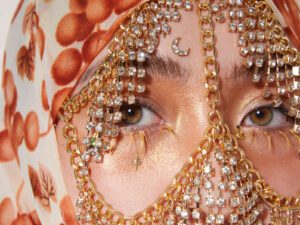In 2004, British-Chinese photographer Grace Lau (b. 1939) was commissioned to work on the illustrated book Picturing the Chinese: Early Western Photographs and Postcards of China. It tells the story of Western photography in China from the mid-19th century to the present. During her research, Lau noticed that the portraits of local Chinese people taken by Western photographers, such as Jon Thomson and William Saunders, were of a certain “type” — beggars, opium smokers, women with bound feet. These images were circulated in the Western world, promoting a skewed, exoticised and, not to mention, racially biased view of the country and its residents. In response, Lau set up her own “Chinese portrait studio” in the seaside town of Hastings in 2005, comprising mock Chinese furniture, a faux panda rug, red paper lamps and a background painted by Robina Barson. Lau invited local residents and holiday-makers to have their portraits made in the studio. Around 400 pictures were taken, some of which form part of Portraits in a Chinese Studio, an exhibition which is entering its final week at the Centre for British Photography, London.

“Through this project I am making an oblique comment on Imperialist visions of the ‘exotic’ Chinese and, by reversing roles, I have become the Imperialist photographer documenting my exotic subjects in the ‘Port’ of Hastings,” says Lau. She opened another, similar studio in The Marlands Shopping Centre, Southampton, in February this year. The results? A couple posing with their dogs, caught mid-smile. A group of girls dressed in bathing suits. A man sat on his mobility vehicle with a cheeky grin on his face; the the label on his vehicle reads “Route 69 Sex King of the Road.” A group of bikers, leather jackets and helmets in tow. These are just some of the people that Lau has photographed in this experimental project, which is as much about subverting racial prejudices as it is about modern studio portraiture.
Lau’s sitters seem relaxed, and are encouraged to include personal objects in their portraits. Water bottles, bags of crisps and a bright green handbag make their way into the images, serving as cues for a better understanding of these men and women than a formal studio environment might allow. None of the images have captions, thus maintaining the sitter’s anonymity and encouraging viewers to form their own narratives. A selection of archival images of Chinese people from the 19th century is also on display. When viewed alongside the contemporary portraits, these historical images help us to engage with ideas of cultural representation, as well as to trace the evolution of photography itself.

As a British-born Chinese woman, Lau occupies the dichotomous space of being a Westerner who’s also perceived as the ‘Other’, something that she has spoken about. It’s no surprise, then, that Lau’s idea of the ‘exotic West’ goes beyond race. She photographs people from different cultural and religious backgrounds. There’s space for a group of stylishly dressed Black youngsters, as well as for a disabled white girl who owns the frame. Even though Lau claims to have become an ‘Imperialist photographer’, her images are inclusive, devoid of stereotypes and a testament to the times in which we are living. In that respect, Portraits in a Chinese Studio is not just about reversing the colonial gaze. It goes beyond that, confidently documenting a multicultural pluralistic society.
Words: Shyama Laxman
All images from Grace Lau, Portraits in a Chinese Studio. Images courtesy the artists and Centre for British Photography.





